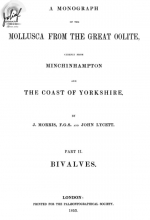Добрый день, Коллеги. Важное сообщение, просьба принять участие. Музей Ферсмана ищет помощь для реставрационных работ в помещении. Подробности по ссылке
Mollusca from the great oolite, chiefly from Minchinhampton and the coast of Yorkshire. Part 2. Bivalves / Моллюски из большого оолита, главным образом из Минчинхэмптона и побережья Йоркшира. Часть 2. Двустворчатые моллюски
Upon a general review of the Oolitic Lamellibranchiate Mollusks, it will be found that a very large proportion consists of shells whose hinges may be arranged under one or other of the following two groups, each of which has various generic modifications. The first consists of a lengthened hinge plate, having a parallel series of transverse or oblique teeth, as exemplified by Area, with its sub-genera Cucullaa, Nueula, Leda, Macrodon, Isoarca, Limopsis. The second kind of hinge is altogether destitute of teeth, and comprises the several genera of fossil Myada, as Pholadomya, &c., Mytilus with Modiola, IAthodomus, Pinna, Trichites, and Thracia. Deducting these, together with the forms whose hinge possesses only a ligamentary fossa, as Lima, Pecten, Hinnites, Plicatula, and those in which the ligament is inserted in distinct pits, as Gervillia, Perna, &c., it will be found that shells with hinge teeth constitute only a minority, and that the great family of the Veneridce, though numerous with respect to individuals and number of species, pertains only to few genera. Experience has led us to distrust many generic names which have been given to these fossils, as Pullastra, Donax, Tellina, Amphidesma, Chama, Lutraria, Sanguinolaria, Mactra, Gastrochcena, and Spondylus; Panopea is also a genus to which a very heterogeneous assemblage of testacea has been referred; Playiostoma has by common consent fallen from the list of genera, the Oolitic species being now referred to Lima. Nor has it in any one instance been ascertained that any of the Oolitic bivalves have spoon-shaped processes corresponding to those of the recent Mya and Lutraria. The shelly beds of the Great Oolite appear to have been accumulated in a sea not sufficiently tranquil to become the habitat of the Myada; the entire family were gregareous, but in the shelly Oolite we rarely discover a single valve of Arcomya, Ceromya, or of Homomya, the other genera of Myadce being absent altogether. <...>




